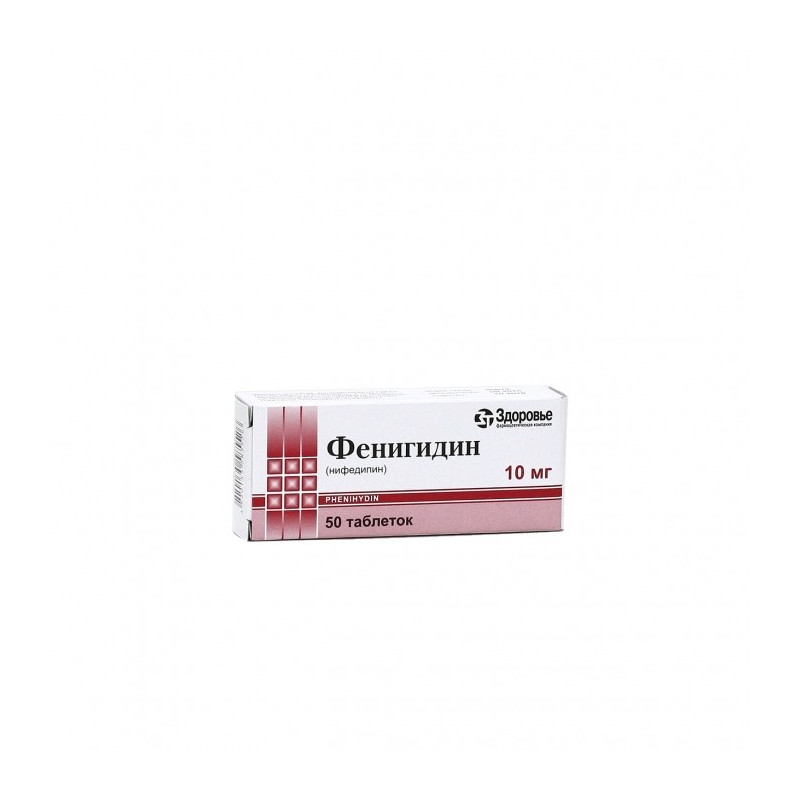



 All payments are encrypted via SSL
All payments are encrypted via SSL
 Full Refund if you haven't received your order
Full Refund if you haven't received your order
50 pcs.
Phenigidin is a Calcium channel blocker derived from dihydropyridine. Inhibits calcium intake in cardiomyocytes and vascular smooth muscle cells. It has antianginal and antihypertensive effects. Reduces the tone of the smooth muscles of blood vessels. It expands the coronary and peripheral arteries, lowers the total peripheral vascular resistance, arterial pressure, decreases the afterload and myocardial oxygen demand.
Pharmacokinetics. When ingestion Fenigidin is rapidly and almost completely (more than 90%) absorbed from the gastrointestinal tract. Bioavailability is approximately 50%. The maximum concentration in the blood plasma is recorded in 20-40 minutes after administration. The onset of clinical effect: 20 min - when administered orally, 5 min - with sublingual. The duration of the clinical effect is 4-6 hours. The half-life is 2-4 hours. It is mainly excreted in the urine as inactive metabolites. No cumulative effect.
Prevention and treatment of strokes; arterial hypertension of various origins, hypertensive crisis.
Hypersensitivity to fenigidin, cardiogenic shock, arterial hypotension, tachycardia, acute period of myocardial infarction (first 8 days), heart failure, pregnancy, children's age.
Since Fenigidin is excreted in breast milk, its use during lactation should be avoided or breast feeding should be stopped during treatment.
The drug is taken orally, without chewing, with a small amount of liquid, regardless of the meal. Simultaneous food intake slows down, but does not reduce the degree of absorption of the drug (some products affect the bioavailability of the drug). Dose set individually. The initial dose for adults - 10 mg (1 tablet), 3-4 times a day. If necessary, gradually increase the dose to 20 mg, 3-4 times a day. The maximum daily dose is 120 mg. To relieve an angina or hypertensive crisis, the drug is used sublingually: 1 pill of 0.01 g is chewed and placed under the tongue; after some time (5-10 minutes), the drug can be swallowed with a small amount of water, it is recommended to lie in a lying position for 30-60 minutes. The duration of treatment is determined by the doctor.
Side effects occur predominantly at the beginning of treatment, usually mild and temporary.More than 1% of patients may experience headache, flushing of the skin of the face and other parts of the body, accompanied by a burning sensation (erythema, erythromegaly), palpitations, swelling of the legs (associated with vasodilation), dizziness, increased fatigue, nausea, feeling of heaviness in the stomach, diarrhea, constipation; in less than 1% of cases, dyspnea, myalgia, tremor, irritability, paresthesia, tachycardia, hypotension, skin rash and itching are possible; less than 0.1% of patients (in some older men, with prolonged therapy) may develop gynecomastia, which fully regresses after discontinuation of the drug; With prolonged treatment, gingival hyperplasia is also possible, which completely disappears after drug withdrawal. Initial hyperglycemia, transient visual disturbances, increased daily diuresis (may be regarded as a positive effect with elevated blood pressure), abnormal liver function (increased transaminase levels, intrahepatic cholestasis), exfoliative dermatitis, photosensitization, systemic allergic reactions, thrombocytopenic purpura, and exfoliative dermatitis, photosensitization, systemic allergic reactions, thrombocytopenic purpura, is rarely observed. These phenomena disappear after drug withdrawal. Due to a decrease in blood pressure, collapse may develop. A sharp decrease in blood pressure due to vasodilation is possible in patients on dialysis, with malignant hypertension and hypovolemia. When treating patients with stable angina for 1 hour after ingestion of fenigidin, pain may appear behind the sternum as a stenocardic.
In some patients, usually at the beginning of treatment, an increase in the frequency, duration, and severity of angina attacks is possible, which requires discontinuation of the drug.
Symptoms: headache, facial skin flushing, prolonged systemic hypotension, bradycardia, bradyarrhythmia. In severe poisoning, collapse, depression of the sinus node is possible. Treatment: administration of norepinephrine, intravenous administration of calcium chloride or Calcium gluconate in atropine solution.
Keep out of reach of children, dry, protected from light, at a temperature of 8 ° C to 15 ° C.
Fenigidin